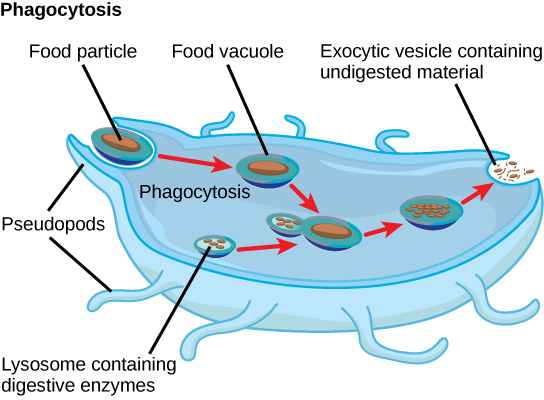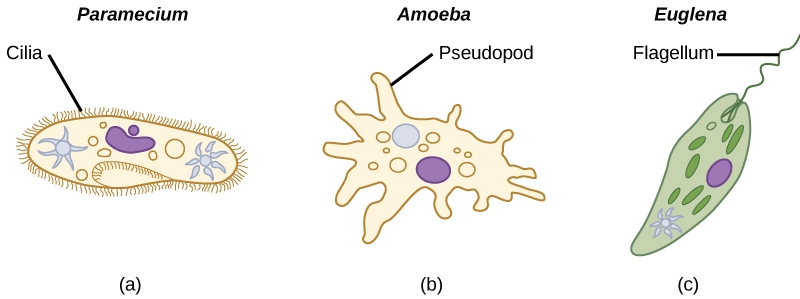Are Protists Unicellular Or Multicellular Are Animals Unicellular
Protists
117 Characteristics of Protists
Learning Objectives
By the end of this department, you will exist able to do the following:
- Depict the cell structure characteristics of protists
- Describe the metabolic diverseness of protists
- Describe the life cycle diverseness of protists
In that location are over 100,000 described living species of protists, and it is unclear how many undescribed species may be. Since many protists live every bit commensals or parasites in other organisms and these relationships are often species-specific, there is a huge potential for protist diversity that matches the diversity of their hosts. Considering the name "protist" serves as a catchall term for eukaryotic organisms that are non animal, plant, or fungi, it is non surprising that very few characteristics are mutual to all protists. On the other hand, familiar characteristics of plants and animals are foreshadowed in various protists.
Cell Structure
The cells of protists are among the most elaborate of all cells. Multicellular plants, animals, and fungi are embedded amid the protists in eukaryotic phylogeny. In most plants and animals and some fungi, complexity arises out of multicellularity, tissue specialization, and subsequent interaction because of these features. Although a rudimentary class of multicellularity exists amongst some of the organisms labelled as "protists," those that take remained unicellular show how complexity can evolve in the absence of true multicellularity, with the differentiation of cellular morphology and function. A few protists live as colonies that carry in some ways as a group of gratis-living cells and in other ways as a multicellular organism. Some protists are composed of enormous, multinucleate, single cells that look like amorphous blobs of slime, or in other cases, like ferns. In some species of protists, the nuclei are different sizes and have singled-out roles in protist jail cell function.
Single protist cells range in size from less than a micrometer to iii meters in length to hectares! Protist cells may be enveloped past animal-like cell membranes or plant-like cell walls. Others are encased in glassy silica-based shells or wound with pellicles of interlocking protein strips. The pellicle functions like a flexible glaze of armor, preventing the protist from being torn or pierced without compromising its range of move.
Metabolism
Protists showroom many forms of nutrition and may be aerobic or anaerobic. Those that shop energy by photosynthesis belong to a group of photoautotrophs and are characterized by the presence of chloroplasts. Other protists are heterotrophic and consume organic materials (such as other organisms) to obtain nutrition. Amoebas and some other heterotrophic protist species ingest particles past a process called phagocytosis, in which the cell membrane engulfs a nutrient particle and brings it inward, pinching off an intracellular membranous sac, or vesicle, called a food vacuole ((Figure)). In some protists, food vacuoles can be formed anywhere on the torso surface, whereas in others, they may be restricted to the base of a specialized feeding construction. The vesicle containing the ingested particle, the phagosome, then fuses with a lysosome containing hydrolytic enzymes to produce a phagolysosome, and the nutrient particle is broken down into small molecules that can diffuse into the cytoplasm and be used in cellular metabolism. Undigested remains ultimately are expelled from the cell via exocytosis.
Phagocytosis. The stages of phagocytosis include the engulfment of a food particle, the digestion of the particle using hydrolytic enzymes contained within a lysosome, and the expulsion of undigested materials from the cell.

Subtypes of heterotrophs, chosen saprobes, absorb nutrients from dead organisms or their organic wastes. Some protists can role as mixotrophs, obtaining nutrition by photoautotrophic or heterotrophic routes, depending on whether sunlight or organic nutrients are available.
Motility
The majority of protists are motile, but different types of protists have evolved varied modes of motility ((Effigy)). Some protists have 1 or more than flagella, which they rotate or whip. Others are covered in rows or tufts of tiny cilia that they beat in a coordinated manner to swim. Still others form cytoplasmic extensions called pseudopodia anywhere on the cell, anchor the pseudopodia to a substrate, and pull themselves forrard. Some protists can motion toward or away from a stimulus, a motion referred to every bit taxis. For case, movement toward light, termed phototaxis, is accomplished by coupling their locomotion strategy with a light-sensing organ.
Locomotor organelles in protists. Protists use various methods for transportation. (a) Paramecium waves hair-like appendages called cilia to propel itself. (b) Amoeba uses lobe-like pseudopodia to anchor itself to a solid surface and pull itself forward. (c) Euglena uses a whip-similar tail called a flagellum to propel itself.

Life Cycles
Protists reproduce by a variety of mechanisms. Most undergo some class of asexual reproduction, such every bit binary fission, to produce 2 girl cells. In protists, binary fission can exist divided into transverse or longitudinal, depending on the axis of orientation; sometimes Paramecium exhibits this method. Some protists such as the truthful slime molds exhibit multiple fission and simultaneously divide into many daughter cells. Others produce tiny buds that proceed to separate and grow to the size of the parental protist.
Sexual reproduction, involving meiosis and fertilization, is mutual among protists, and many protist species can switch from asexual to sexual reproduction when necessary. Sexual reproduction is often associated with periods when nutrients are depleted or environmental changes occur. Sexual reproduction may let the protist to recombine genes and produce new variations of progeny, some of which may be better suited to surviving changes in a new or changing environment. Nonetheless, sexual reproduction is often associated with resistant cysts that are a protective, resting stage. Depending on habitat of the species, the cysts may be especially resistant to temperature extremes, desiccation, or low pH. This strategy allows certain protists to "wait out" stressors until their environment becomes more favorable for survival or until they are carried (such as by wind, water, or ship on a larger organism) to a dissimilar environment, because cysts exhibit nigh no cellular metabolism.
Protist life cycles range from elementary to extremely elaborate. Certain parasitic protists have complicated life cycles and must infect different host species at different developmental stages to complete their life cycle. Some protists are unicellular in the haploid form and multicellular in the diploid form, a strategy employed by animals. Other protists have multicellular stages in both haploid and diploid forms, a strategy chosen alternation of generations, analogous to that used by plants.
Habitats
Nearly all protists be in some type of aquatic environment, including freshwater and marine environments, damp soil, and fifty-fifty snowfall. Several protist species are parasites that infect animals or plants. A few protist species alive on dead organisms or their wastes, and contribute to their decay.
Department Summary
Protists are extremely various in terms of their biological and ecological characteristics, partly considering they are an artificial assemblage of phylogenetically unrelated groups. Protists display highly varied cell structures, several types of reproductive strategies, nearly every possible type of nutrition, and varied habitats. Nigh single-celled protists are motile, merely these organisms utilise diverse structures for transportation.
Review Questions
Protists that take a pellicle are surrounded past ______________.
- silica dioxide
- calcium carbonate
- carbohydrates
- proteins
D
Protists with the capabilities to perform photosynthesis and to absorb nutrients from dead organisms are called ______________.
- photoautotrophs
- mixotrophs
- saprobes
- heterotrophs
B
Which of these locomotor organs would likely be the shortest?
- a flagellum
- a cilium
- an extended pseudopod
- a pellicle
B
Alternation of generations describes which of the following?
- The haploid form can exist multicellular; the diploid class is unicellular.
- The haploid class is unicellular; the diploid form can exist multicellular.
- Both the haploid and diploid forms can be multicellular.
- Neither the haploid nor the diploid forms can be multicellular.
C
The amoeba Due east. histolytica is a pathogen that forms liver abscesses in infected individuals. Its metabolic classification is most likely ______.
- Anaerobic heterotroph
- Mixotroph
- Aerobic phototroph
- Phagocytic autotroph
A
Critical Thinking Questions
Explicate in your ain words why sexual reproduction tin can be useful if a protist's environment changes.
The ability to perform sexual reproduction allows protists to recombine their genes and produce new variations of progeny that may exist better suited to the new environment. In dissimilarity, asexual reproduction generates progeny that are clones of the parent.
Giardia lamblia is a cyst-forming protist parasite that causes diarrhea if ingested. Given this information, against what type(s) of environments might G. lamblia cysts be particularly resistant?
Equally an intestinal parasite, Giardia cysts would be exposed to low pH in the stomach acids of its host. To survive this surroundings and accomplish the intestine, the cysts would have to exist resistant to acidic weather condition.
Explain how the definition of protists ensures that the kingdom Protista includes a wide diversity of cellular structures. Provide an example of two different structures that perform the same function for their corresponding protist.
Protists are divers as whatever eukaryotes that do not fall into the Plantae, Fungi, or Animate being Kingdoms. Since the unifying characteristics draw what they are NOT, rather than what they are, Protista can include most any cellular/organism arrangement.
Possible examples of structure variety:
- Barrier to exterior world: jail cell wall, plasma membrane, pellicle
- Locomotion: flagella, cilia, pseudopodia
Glossary
- mixotroph
- organism that can obtain nutrition by autotrophic or heterotrophic means, ordinarily facultatively
- pellicle
- outer cell covering composed of interlocking poly peptide strips that office similar a flexible glaze of armor, preventing cells from being torn or pierced without compromising their range of motion
- phagolysosome
- cellular body formed past the spousal relationship of a phagosome containing the ingested particle with a lysosome that contains hydrolytic enzymes
Source: https://opentextbc.ca/biology2eopenstax/chapter/characteristics-of-protists/
Posted by: brubakergoour1986.blogspot.com

0 Response to "Are Protists Unicellular Or Multicellular Are Animals Unicellular"
Post a Comment